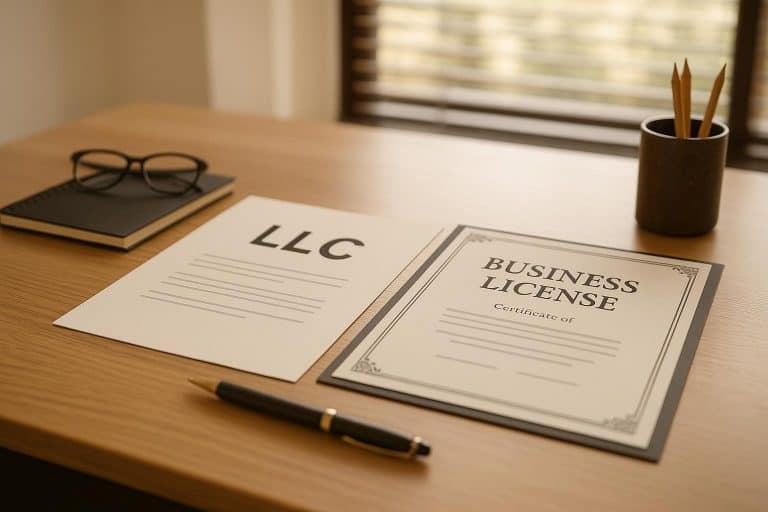Dissolving an LLC in Ohio means officially closing your business and removing it from state records. Here’s how to do it properly:
- Decide to Dissolve: Review your LLC’s operating agreement and hold a formal meeting to vote on dissolution. Document the decision with a signed resolution.
- Settle Debts: Pay off all debts, taxes, and financial obligations. Notify creditors and allow at least 60 days for claims.
- Distribute Assets: Divide remaining assets among members as per the operating agreement or Ohio laws.
- File Certificate of Dissolution: Submit Form 616 to the Ohio Secretary of State with a $50 fee. You can file online or by mail.
- Wrap Up Tax Accounts: File final tax returns with the IRS and Ohio Department of Taxation. Close all business licenses and permits.
Key Details:
- Filing Fee: $50
- Processing Time: 3–5 business days (expedited options available)
- Notification Period for Creditors: At least 60 days
Proper dissolution avoids ongoing fees, taxes, or legal risks. Keep all records for at least 7 years. For help, consult a legal or tax professional.
Step 1: Review Your Operating Agreement and Vote to Dissolve
Start with Your Operating Agreement
Your operating agreement is your LLC’s roadmap for handling important decisions, including dissolution. This document outlines the rules for critical processes like voting, profit distribution, management decisions, and, of course, how to officially dissolve the LLC.
Before doing anything else, carefully review your operating agreement for any specific conditions that trigger dissolution. According to Ohio Revised Code Section 1706.47, an LLC dissolves when an event or circumstance outlined in the agreement occurs. These triggers might include reaching a specific date, achieving a particular business milestone, or other predefined conditions.
The operating agreement should also detail how the LLC’s assets will be divided among members during the winding-up process. This information is crucial as you prepare to settle the company’s affairs.
If your LLC doesn’t have an operating agreement, Ohio’s default laws require unanimous consent from all members to dissolve the business. Without this agreement, managing the dissolution process can become more complicated, and you might face legal uncertainties. In such cases, consulting a professional familiar with Ohio state laws is a smart move.
Once you’ve reviewed your agreement and understand the steps, it’s time to make the dissolution decision official.
Schedule a Meeting and Record the Decision
With the operating agreement in hand, the next step is to hold a formal meeting with all LLC members. This meeting is not just a formality – it’s a legal requirement in Ohio. All members must agree to dissolve the LLC, so their participation and consent are essential.
During the meeting, discuss the reasons for dissolving the business and ensure everyone understands the financial and legal implications. Once the discussion is complete, vote according to the procedures outlined in your operating agreement. Keep in mind, this decision impacts everyone involved, from financial interests to future responsibilities.
After the vote, document the decision in a formal resolution. This resolution should include a clear statement of dissolution, the meeting date, and signatures from all members. It’s not just a piece of paper – it’s your legal proof that the decision to dissolve was made properly. This documentation can protect your LLC from potential disputes down the road.
Make sure to keep multiple copies of the signed resolution. You’ll likely need it when filing your Certificate of Dissolution with the Ohio Secretary of State, notifying creditors, addressing tax obligations, and completing other dissolution-related tasks.
Having this resolution in your records creates a reliable paper trail, showing that your LLC followed the correct procedures. If any questions arise later about the validity of your dissolution, this document will be invaluable.
Step 2: Settle Debts, Notify Creditors, and Wind Up Business Affairs
Pay Off Debts and Close Tax Accounts
Once you’ve officially decided to dissolve your LLC, the next step is to address all financial obligations. According to Ohio law, clearing your debts is a necessary part of the dissolution process, ensuring that your LLC and its members are shielded from future liabilities.
Start by creating a comprehensive list of outstanding debts. This should include business loans, unpaid invoices, employee wages, vendor payments, and administrative fees. Don’t forget tax obligations – this means any fines, state or federal taxes, and other related fees.
If your LLC is facing significant debts, consider negotiating with creditors for repayment plans or lump-sum settlements. Many creditors prefer partial payment upfront rather than waiting through drawn-out legal proceedings. For particularly complex debt situations, hiring a licensed insolvency practitioner can streamline the process and ensure professional handling of asset distribution and settlements.
Once all debts are resolved, close any tax accounts with state tax authorities and the IRS. This step is crucial for avoiding future tax notices and ensures a clean exit from compliance requirements. With your financial obligations sorted, you can move on to notifying creditors.
Notify Creditors and Handle Claims
After settling debts, it’s time to formally notify creditors. Ohio law requires written notification to all known creditors and claimants about your LLC’s pending dissolution. This step is essential to avoid future legal complications.
Your notice should clearly outline how creditors can submit claims, the address for sending them, and a deadline for submission. Ohio law mandates that this deadline must be at least 60 days after the notice is sent. Additionally, include a statement that claims not submitted by the deadline will be barred and that the LLC may distribute assets without further notice.
To ensure accountability, send these notices via certified or registered mail and keep detailed records of all communications.
Once the claim period ends, review the submitted claims. Pay valid claims promptly, but for those you believe are invalid, provide written rejection notices. These notices should explain why the claim was rejected and inform the creditor of their right to pursue legal action.
"A claim is barred if a claimant that was given written notice under Division (A) of this section does not deliver the claim to the dissolved corporation by the deadline stated in the notice." – Ohio Revised Code §1701.87, Section (D)
Distribute Remaining Assets
With all debts paid and creditor claims resolved, the final step is distributing any remaining assets to LLC members. This process must follow the terms set in your operating agreement. If no such terms are outlined, Ohio’s default laws will guide the distribution.
Under Ohio Revised Code §1706.29, members typically share equally in distributions made before dissolution and winding up. However, many operating agreements specify distributions based on ownership percentages, which take precedence.
If no specific terms are provided, Ohio law generally follows a two-step approach: first, members receive a return of their initial contributions, and second, any remaining assets are divided according to membership interests.
Document every distribution carefully. Record the date, amount, recipient, and reason for each distribution. These records serve as protection against future disputes and provide clarity for tax purposes or potential audits.
Step 3: File the Certificate of Dissolution with the Ohio Secretary of State
Complete and Submit the Certificate of Dissolution
After wrapping up your business operations, the next step is to file the official paperwork to dissolve your LLC. In Ohio, this involves submitting Form 616, also known as the Certificate of Dissolution, to the Ohio Secretary of State.
The filing fee for this process is $50.00, which must be paid at the time of submission. You have two options for filing:
- Online: Use the Ohio Business Central website at www.OhioBusinessCentral.gov.
- By Mail: Complete Form 616 and send it, along with a $50 check or money order payable to the Ohio Secretary of State, to the address listed on the form.
Make sure all the details in your Certificate of Dissolution are accurate. This includes your LLC’s exact legal name (as it appears in your Articles of Organization), its registration number, and the effective date of dissolution. The Ohio Secretary of State requires confirmation that your debts have been cleared, creditors have been notified, and assets have been distributed.
Get Confirmation from the State
Once you’ve submitted your Certificate of Dissolution, the Ohio Secretary of State will review and process your filing. Typically, this takes 3–5 business days, whether you file online or by mail. Online submissions may be processed slightly faster.
If you’re in a hurry, expedited processing options are available for an extra fee:
| Processing Speed | Additional Fee | Availability |
|---|---|---|
| Within 2 business days | $100 | Mailed and in-person filings |
| 1 business day | $200 | In-person filings only |
| Within 4 hours | $300 | In-person filings only |
Keep in mind that expedited processing may not apply to all types of filings.
Once your filing is processed, you’ll receive official confirmation from the state. This document serves as proof that your LLC has been formally dissolved and removed from Ohio’s records. It’s a critical piece of paperwork for tax purposes, closing business accounts, and demonstrating that your LLC no longer exists as a legal entity.
At this point, your LLC’s legal existence officially ends. It can no longer conduct business, enter into contracts, or act as a legal entity. Any attempt to operate after dissolution could lead to personal liability for the former LLC members.
If you don’t receive confirmation within the expected timeframe, reach out to the Ohio Secretary of State’s office to check your filing status. Issues like incomplete paperwork can sometimes cause delays, and early follow-up can help address any problems quickly.
This confirmation marks the final step in dissolving your LLC, allowing you to focus on any remaining post-dissolution responsibilities.
sbb-itb-ba0a4be
After Dissolution: Final Requirements and Best Practices
Keep Records and Update the IRS
After dissolving your LLC, keeping thorough records is essential to protect yourself from audits, lawsuits, or compliance issues. Agencies like the SBA and various state authorities recommend holding onto most business records for at least seven years after closing.
Here’s a breakdown of key documents and how long you should retain them:
| Document Type | Retention Period |
|---|---|
| Federal, state, and local tax returns | At least 7 years |
| Employment tax records | At least 4 years |
| Employment records | At least 1 year |
| Asset records | At least 3 years after disposing of the asset |
| Insurance files | Permanently |
| Business documents (Articles of Organization, dissolution papers) | Permanently |
| Financial records | At least 7 years |
Small businesses are often at a higher risk for audits compared to individual taxpayers. Even after shutting down, businesses may still face legal challenges or inquiries, so maintaining records is crucial. These documents can help substantiate tax filings and demonstrate responsible business practices if agencies like the Department of Labor come knocking.
Make sure to notify the IRS about your dissolution by filing your final tax returns. Check the box that indicates it’s your final return. Depending on your LLC’s tax classification, you’ll need to submit the appropriate income tax return (Forms 1065, 1120, or 1120S) along with employment tax returns if you had employees. While your EIN will remain linked to your business, the IRS will mark it as closed.
For state-specific requirements, such as in Ohio, ensure you close all tax accounts with the Ohio Department of Taxation. This includes filing your final sales tax return, completing the Ohio Business Account Update Form for employer withholding taxes, and canceling your Commercial Activity Tax (CAT) account.
"There are many issues related to the closing of a business, but from a tax perspective, the most important is making sure you’ve taken care of any trust fund taxes that might exist." – Steve Dimengo, Tax Attorney
Avoid Common Mistakes
Even after dissolving your business, certain mistakes can come back to haunt you. These are some common errors to avoid:
- Failing to File a Certificate of Dissolution: Without this document, you may still owe state fees and penalties, even if your business is no longer active.
- Not Settling Debts: If you don’t clear debts before dissolution, creditors could pursue legal action against former LLC members, putting personal assets at risk. Notify all creditors and give them a clear deadline for submitting claims.
- Ignoring Final Tax Obligations: Missing state or federal tax filings, such as Ohio’s IT 1140, can lead to audits and penalties.
- Overlooking Business Licenses and Permits: Forgetting to cancel licenses, like an Ohio sales tax permit, could leave you responsible for ongoing filings and payments. Contact all relevant agencies to formally cancel registrations.
- Neglecting Withdrawals from Other States: If your LLC was registered in multiple states, you must file withdrawal documents in each one. Failing to do so can result in ongoing fees and compliance requirements.
Use Tools for Compliance and Efficiency
To simplify the process of managing post-dissolution tasks, consider using compliance tools that help you stay organized and meet deadlines.
These tools can centralize all your dissolution-related paperwork, such as your Certificate of Dissolution and final tax returns, making it easy to access what you need. Automated alerts can remind you of key deadlines, like license cancellations, while compliance tracking features ensure you’re staying on top of both completed and pending tasks.
For LLCs with operations across multiple states, these tools can be especially helpful in coordinating dissolution requirements in different jurisdictions. Additionally, they often provide secure, long-term document storage for at least seven years, keeping you covered for any future inquiries or audits.
Conclusion: How to Dissolve Your LLC in Ohio
Closing your LLC in Ohio requires careful attention to state laws and specific steps to ensure everything is done properly. The process includes reviewing your LLC’s foundational documents, paying off any debts, filing a Certificate of Dissolution with the Ohio Secretary of State (along with a $50 fee), and keeping key records for at least seven years.
Taking these steps is essential to protect yourself from future liabilities. If you skip formal dissolution, you could still be on the hook for state fees, tax penalties, or even business debts. The Ohio Revised Code Chapter 1706 outlines the legal framework for dissolving an LLC, and the Certificate of Dissolution typically takes effect 90 days after filing unless you specify a different timeline. Additionally, Ohio law includes a mandatory waiting period for creditors to make claims.
Once you’ve completed all the legal and financial requirements, thorough record-keeping becomes crucial. Keep documents like your Certificate of Dissolution, meeting minutes, final tax returns, and creditor notifications organized and accessible. These records can serve as proof that you followed the proper steps and fulfilled all obligations, which can be invaluable in case of audits or legal issues.
It’s important to understand that formally dissolving your LLC is not the same as simply stopping operations. Formal dissolution legally ends your LLC’s existence, eliminates future tax responsibilities, and shields members from lingering liabilities. Failing to follow the proper process could leave you exposed to lawsuits, penalties, or unexpected tax bills.
If you’re uncertain about any part of the dissolution process, it’s wise to seek advice from legal or tax professionals. For official forms and additional guidance, the Ohio Secretary of State’s website is a great resource to help you navigate the process.
FAQs
What happens if I don’t properly dissolve my LLC in Ohio?
If you don’t officially dissolve your LLC in Ohio, you could face some serious legal and financial headaches. Even if your business isn’t operating anymore, state fees and taxes might keep piling up. On top of that, creditors might still come after the LLC – or even its members – if debts are left unpaid or if proper notifications weren’t sent out.
Skipping the step of filing a Certificate of Dissolution with the Ohio Secretary of State can also leave your LLC on the hook for liabilities. In certain situations, members might even end up with personal liability for unresolved obligations. Taking the right steps to dissolve your LLC isn’t just about checking a box – it’s about avoiding lingering responsibilities and protecting yourself from unnecessary risks.
How do I notify creditors and settle claims when dissolving an LLC in Ohio?
When dissolving an LLC in Ohio, it’s essential to notify creditors and address any claims properly. Start by sending written notices to all known creditors and claimants. Using certified mail is a common practice, as it provides proof of delivery. These notices should clearly outline the dissolution process and request any outstanding claims. Creditors are typically given a minimum of 90 days to respond.
To reach a wider audience, consider publishing a notice in a local newspaper. This step can help ensure that anyone with a potential claim is informed. Before officially filing for dissolution, make sure all debts and liabilities are completely resolved. This helps avoid any lingering legal or financial complications. Lastly, maintain thorough records of all communications and settlements to stay compliant with Ohio’s legal requirements.
What steps should I take to dissolve my LLC in Ohio if I don’t have an operating agreement?
If your Ohio LLC doesn’t have an operating agreement, the dissolution process will default to the rules set by Ohio state laws, specifically those outlined in the Ohio Revised Code. Generally, this means members will need to vote to approve the dissolution, address any outstanding debts, notify creditors, and divide any remaining assets.
Once these steps are completed, you’ll need to file a Certificate of Dissolution with the Ohio Secretary of State to officially close your LLC. Without an operating agreement in place, the process follows state guidelines rather than internal policies, but the steps are still fairly straightforward. Make sure to resolve all financial obligations and meet legal requirements to stay in compliance with Ohio law.









